
2020 Presidential Results. Key: Navy – 65%+ Biden, Blue 60-64.9%, Royal Blue 55%-59.9%, Dodger Blue 50%-54.9%, Light Sky Blue <50%. Light Salmon <50% Trump, Coral 50%-54.9%, Orange Red 55%-59.9%, Red 60%-64.9%, Maroon 65%+. Ties are yellow. (All maps by Nick Field via Dave’s Redistricting)![]()
Joe Biden was succinct and to the point when describing his 2020 strategy to reporters in late October, telling them “We have to re-establish the Blue Wall.”
Taking back the Rust Belt trio of Michigan, Pennsylvania and Wisconsin was his campaign’s primary priority. With polling showing PA as the closest of the three, on top of the fact that it’s worth the most electoral votes, the Keystone State was considered the unanimous top toss-up of 2020.
Since Biden was born in Scranton and spent his life in nearby Delaware, he was uniquely equipped to contest the commonwealth. His team identified it early on as an absolute must-win state and crafted their entire campaign with that in mind. The following is an examination of just how Joe Biden managed to prevail in Pennsylvania.
Now, explaining election results is of course an inherently enigmatic exercise. Elections involve hundreds of millions of voters deciding thousands of races across a vast nation. It shouldn’t be surprising that they rarely supply concise conclusions.
Nevertheless I found that an examination of precinct-level results, as well as of the wider campaign, was an especially enlightening exercise in 2016. This time I can compare and contrast those results to 2020, and present a clear and detailed view of the ways the electorate has changed. With the what in place, it’s possible to pursue the how.
For example, the simplest and most obvious observation from looking at the data is that Joe Biden’s win was pieced together from small widespread gains which allowed him to consistently chip away at Trump’s 2016 advantage.
According to Biden Campaign Manager Jen O’Malley-Dillon, this outcome was no accident. In a post-election podcast interview with Obama campaign vet David Plouffe, she described their game plan.
“We weren’t willing to just do the things that people would typically do. Just go to Philly, just go to Pittsburgh. We knew we had to increase our margins in these other counties,” O’Malley-Dillon explained. “You always want to go super-deep in areas but we also had to go incredibly wide across the whole state in order to come up with the margins.”
This initiative to compete everywhere was mostly successful, and when the dust finally settled, Joe Biden won Pennsylvania by 81,660 votes. Since Hillary Clinton fell 44,292 votes short four years ago, the total shift was only about 125K.
Let’s take a deep-dive into every corner of the commonwealth and see how the Biden team put together their victory.
Southeast
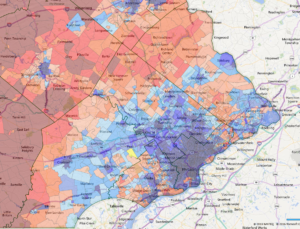

It was a foolish dream in 2016, but in 2020 it made all the difference.
Four years ago, the Democratic plan was to run up the margins in Philadelphia and its collar counties so high that they would overcome losses everywhere else. As Chuck Schumer put it back then, “For every blue-collar Democrat we lose in western Pennsylvania, we will pick up two moderate Republicans in the suburbs in Philadelphia.” Joe Biden ultimately achieved the suburban performance that Hillary Clinton so sorely needed.
The former VP’s combined advantage in Bucks, Chester, Delaware and Montgomery Counties ended up at 293,034 votes, a significant jump from Hillary’s edge of 188,353. Since Biden’s final statewide lead was 81,660, the increase of nearly 105,000 to his SEPA margin proved pivotal. Furthermore, this is particularly impressive given that Trump was actually able to reduce his Philadelphia deficit from 475,277 to 471,050.
Biden’s strongest growth came in Eastern Chester and Central Bucks, white collar suburbs that were once Republican areas before Donald Trump took over the GOP. The President actually campaigned in the Central Bucks township of Upper Makefield, only to see three of its four districts go blue. At the same time, the Democratic nominee did a decent job stemming the working-class exodus in Lower Bucks, where he made his own late stop in Bristol.
While Biden did superb in the suburbs, he couldn’t keep up that pace in Philadelphia. Mirroring a national trend, he actually did slightly worse than Clinton in Philly, as Trump reduced his deficit there from 475,277 to 471,050. The incumbent accomplished this by flipping some wealthier precincts in South Philly and improving his totals in heavily Latino districts.
Northeast (Scranton/Wilkes-Barre)

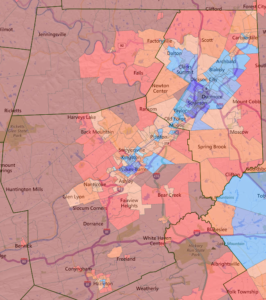
Back in 2016, I noted that the shifts in Lackawanna and Luzerne Counties from Obama to Clinton were enough to swing the state to Trump all on their own. As a result, Scranton native Joe Biden made this portion of PA a major priority.
The candidate made several stops here in the summer and fall, with a heavy focus on his hometown. First of all, Biden unveiled his ‘Build Back Better’ economic recovery plan in Scranton. Later on, it was the site of a CNN Town Hall that served as an early example of the drive-in format the campaign frequently employed. It was also at this event where Biden first introduced his final major slogan, categorizing the race as “between Scranton and Park Avenue”. Finally, he began Election Day with a visit to his childhood home.
All that attention paid off on November 3rd as Biden scored three point improvements in both Lackawanna and Luzerne. Likewise, he made up ground in other neighboring spots. Among these areas was Monroe, home to the tourist-friendly Pocono Mountains, as well as ruby-red counties like Pike and Montour. This suggests that Biden’s focus on the Scranton TV market paid serious dividends.
South Central
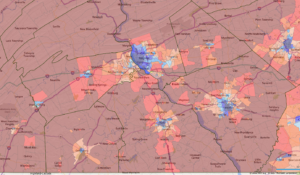
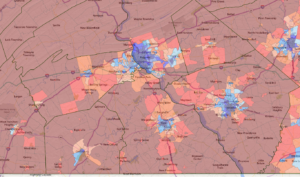
You may not realize just how populous this region of Pennsylvania is, or just how fundamental it is to Republican candidates. After all, Trump scored his largest surplus of votes in Lancaster and York Counties.
Accordingly, this area is a prime contender for O’Malley-Dillon’s theory that margin control was critical for Biden’s candidacy. For instance, the suburbs around each county seat allowed the Democratic nominee to secure a swing of about four points in both Lancaster and York. As a result, Donald Trump emerged with about 4,000 less net votes there compared to 2016.
Speaking of swings, one of the largest came in Cumberland. Continuing a trend we saw in 2016 and 2018, municipalities like Camp Hill, Lemoyne and even Hampden are becoming blue-tinted suburbs of Harrisburg. For this reason, Cumberland is the favorite to be the first 2020 Trump county to eventually flip Democratic.
Meanwhile, across the Susquehanna, Democrats are building quite the blue bulwark. Four years ago, Hillary netted 3,843 votes out of Dauphin. This year Joe Biden emerged with a 12,575 vote advantage. With townships like Derry and Swatara moving left, that number is only going to grow in 2024.
Northwest (Erie)
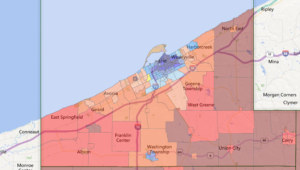
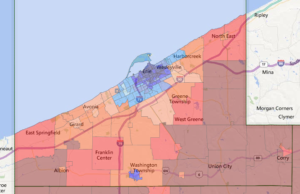
In the run-up to Election Day, Lt. Governor John Fetterman was fond of telling anyone who would listen that whoever won Erie would win PA, and thus the White House. He proved to be prescient, as the state’s sole lakeside county was one of two to flip from Trump to Biden.
As you can see from the maps, once again it was the suburban surge that fueled Erie’s small but significant shift. Not coincidentally, Erie was one of several places that Hillary neglected to visit but where Biden made sure to make a campaign stop.
Ironically, given what he told his audience, Trump probably should’ve skipped his visit to Erie. On October 21st, he famously told his crowd that he didn’t want to be there. “You know, before the plague came in, I had it made,” he declared. “I wasn’t coming to Erie. I mean, I have to be honest. There was no way I was coming.”
You might be skeptical of this conclusion, but that remark did get plenty of coverage, and Trump’s deficit in Erie ended up only being around 1%.
Lehigh Valley


After the glimpse we got in Philadelphia, the Lehigh Valley provides a fuller view of Biden’s under-performance with Hispanics. Allentown, Reading and Bethlehem each have Latino-heavy districts where Biden struggled to match Clinton’s totals. His strength in the suburbs, however, allowed him to overcome these deficits both here and throughout the country.
Additionally this sector of the state is home to Northampton, the other Trump/Biden county. The Democratic nominee turned a 3.8% defeat here in 2016 into a narrow 0.7% win. Meanwhile he scored an even larger victory in Lehigh (4.7% to 7.6%), while trimming the shortfall in Berks (9.9% to 8.1%).
Nevertheless, this was perhaps the sole region where Biden left votes on the table, as it was the one part of the commonwealth where Donald Trump outworked him on the campaign trail. All the way back in May, when most of the country was in lockdown, Pres. Trump was holding an event in Lehigh County. He then returned in late October with stops in Allentown and Reading. Conversely Biden himself never campaigned here, instead delegating the area to Kamala Harris, who made a visit to Northampton the day before the election.
Southwest


This was the corner of the state that powered Trump’s rise in 2016, and racking up even more massive margins here was critical to his re-election strategy. After all it was in Butler on Halloween where he proclaimed “We win Pennsylvania, we win it all — you know that, right?”
So was Trump able to improve his performance in Southwest PA? Yes…and no.
In contrast to the eastern half of the state, where Biden posted small yet significant boosts, Trump was able to continue to run up the score in the Southwest. This was especially apparent in Greene and Fayette counties, which lie on the West Virginia border, where the incumbent benefitted from notable surges in support.
The key difference from 2016, though, was in the counties which surround Allegheny. Beaver, Butler, Washington and Westmoreland all swung a few points towards Joe Biden, driven by voters in the towns along the Ohio and Monongahela Rivers.
At the same time, thanks to gains in the Pittsburgh suburbs, Biden put up a stellar number in Allegheny County. In fact his 146,761 vote margin there was the third-highest in history, behind only FDR in 1936 and LBJ in 1964.
Biden’s relative success here was a noteworthy product of his strategy to make as many personal appearances as possible, including several meaningful events. As the Trump team sought to shift the focus from COVID to law and order, Biden traveled to Pittsburgh to give a rejoinder in which he condemned both Trump’s calls to violence as well as rioting and looting. In their post-election write-up, The New York Times would cite this address as essential to his eventual victory.
Although, as O’Malley-Dillon mentioned, the Biden team wasn’t content to just visit Pittsburgh. After the raucous first debate, the candidate embarked on a train tour that made numerous stops in Westmoreland County, before concluding with an evening rally in Johnstown. Biden even spent Election Eve in Beaver County. This approach prevented Trump from building a red wave sufficient enough to once again sweep the state.
Looking Ahead
“We’ve rebuilt the Blue Wall in the middle of the country that crumbled just four years ago,” Joe Biden declared the Friday after the election.
He knowingly and specifically crafted his entire campaign towards winning Pennsylvania (and similar states) by maximizing his support in the suburbs and cutting into Trump’s margins in rural areas. The former was a definite success while the latter was more of a qualified victory.
This was enough in 2020, but it’s unclear if it could work again in 2024, especially if Biden does not seek a second term. Looking ahead, the Democrats face a pair of serious long-term difficulties: they’ve hit a ceiling in Philadelphia and they’re experiencing an erosion of Latino support.
On the other side, it remains to be seen whether a non-Trump GOP candidate could attract the same level of rural white turnout as he did. In spite of that, it’s worth remembering that there are still limits on Trump’s appeal. In two elections, he won 48.1% and 48.8% of the vote in PA respectively. The Trump playbook can get you a plurality but not a majority, leaving a miniscule margin of error.
The Biden blue-print was far from perfect, yet in 2020 it was exactly what the Democratic Party needed to defeat Donald Trump and once again make Pennsylvania a vital piece of that Blue Wall.